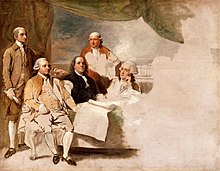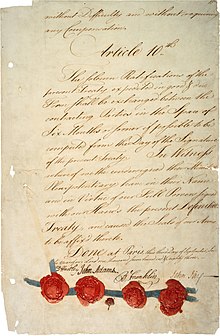Treaty of Paris (1783)
The treaty was drafted on November 30, 1782,[a] and signed at the Hôtel d'York at present-day 56 Rue Jacob in Paris on September 3, 1783, by Adams, Franklin, Jay, and Hartley.Vergennes developed treaty terms under which Spain would forego holding Gibraltar and the United States would be granted independence, but it would be confined to the area east of the Appalachian Mountains.[9] The United States would gain fishing rights off Nova Scotia's coasts and agreed to allow British merchants and Loyalists to try to recover their property.France's only net gains were the island of Tobago, and Senegal in Africa, but it also reinforced earlier treaties, guaranteeing fishing rights off Newfoundland.Historians such as Alvord, Harlow, and Ritcheson have emphasized that British generosity was based on a statesmanlike vision of close economic ties between Britain and the United States.The concession of the vast trans-Appalachian region was designed to facilitate the growth of the American population and to create lucrative markets for British merchants without any military or administrative costs to Britain.[19] Privileges that the Americans had received from Britain automatically when they had colonial status, including protection from pirates in the Mediterranean Sea were lost.Additionally, the Treaty of Paris did not explain how the new border would function in terms of controlling the movement of people and trade between British North America and the United States.[24] Great Britain violated the treaty stipulation that it would relinquish control of forts in United States territory "with all convenient speed".




Treaty of Paris (1763)Treaty of Paris (disambiguation)Kingdom of FranceKingdom of Great BritainUnited StatesDavid HartleyJohn AdamsBenjamin FranklinJohn JayGreat BritainUnited States governmentWikisourceGeorge IIIAmerican Revolutionary WarThirteen ColoniesBritish AmericaboundariesBritish North AmericaCanadaprisoners of warFranceDutch RepublicPeace of Parissovereignindependent statesTreaty of ParisBenjamin WestHenry LaurensWilliam Temple FranklinNorth AmericaGeorge WashingtonContinental ArmyRichard OswaldVergennescapture Gibraltar from the BritishAppalachian Mountainsarea north of the Ohio RiverProvince of QuebecIndian barrier stateLondonLord ShelburneLansdowne HouseLansdowne ClubMississippi RiverFloridaNova ScotiaWest FloridaTreaty of MadridMenorcathe BahamasGrenadaMontserratTobagoSenegalNewfoundlandEast IndiesDutch East IndiesCongress of the ConfederationJanuary 14, 1784Annapolis, MarylandMaryland State HousePreambledivine providenceProvince of New HampshireProvince of Massachusetts BayColony of Rhode Island and Providence PlantationsConnecticut ColonyProvince of New YorkProvince of New JerseyProvince of PennsylvaniaDelaware ColonyProvince of MarylandColony of VirginiaProvince of North CarolinaProvince of South CarolinaProvince of GeorgiaBritish CrownGrand BanksGulf of Saint LawrenceLoyalistsPrisoners-of-warEschatocolgovernment that considered Vermont not to be a part of the United StatesMediterranean SeaLoyalistCommonwealth of Virginiageography of North AmericaWest Florida Controversymost northwesternmost pointLake of the WoodsMinnesotaManitobaOntarioJay TreatyGreat Lakes regionLake ChamplainNorthwest Indian Warfederal government of the United StatesFort au FerChamplain, New YorkNorth Hero, VermontFort LernoultFort DetroitDetroit RiverDetroitMichiganFort MackinacStraits of MackinacMackinac Island, MichiganFort MiamiMaumee RiverMaumee, OhioFort NiagaraNiagara RiverYoungstown, New YorkFort OntarioLake OntarioOswego, New YorkFort OswegatchieSaint Lawrence RiverOgdensburg, New YorkBattle of Kedges StraitChesapeake BayConfederation PeriodUS ConstitutionDiplomacy in the American Revolutionary War